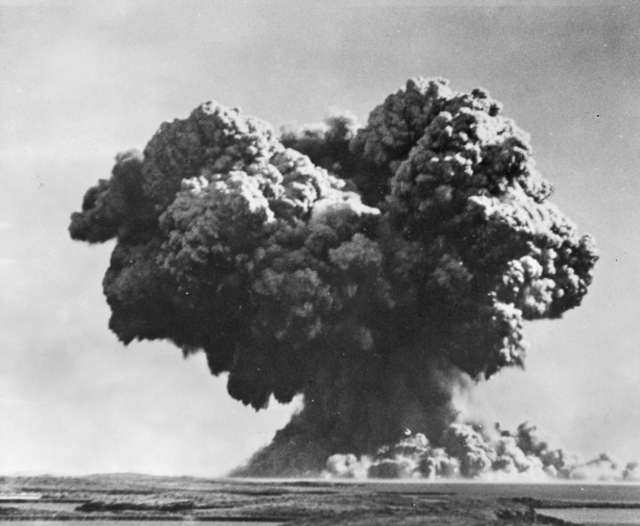Explosion cloud from the Operation Hurricaneatomic bomb test, October 3, 1952. Operation Hurricane was the first British nuclear test (a plutoniumimplosion device) on 3 October 1952. This was detonated in the lagoon between the Montebello Islands, Western Australia.
---------------
Richard Tanter, Senior Research Associate at the Nautilus Institute, University of Melbourne, wrote an excellent article of May 27, 20133 which comments on an article by Tanya Ogilvie-White. Excellent because of its coverage rather than its conclusions. This article was originally published in the Australian Security Policy Institute (ASPI) Blog, The Strategist.
"No progress on extended nuclear deterrence in 2013 White Paper"
"Tanya Ogilvie-White’s reading of the 2013 Defence White Paper suggests significant changes in the role nuclear weapons play in Australian strategic policy, which give grounds for optimism. Yet all might not be as it seems.
She notes that the 2009 White Paper stated that ‘the best defence against WMD proliferation will continue to be found in security assurances, including US extended deterrence’, suggesting that US nuclear protection was intended to cover chemical and biological weapons threats, as well as nuclear ones. By contrast, she writes, the 2013 statement:
…specifically limits Australian reliance on US nuclear weapons to circumstances in which Australia is threatened with a nuclear attack: ‘we rely on the nuclear forces of the United States to deter nuclear attack on Australia.Unfortunately, the 2009 White Paper said virtually the same thing, almost word for word. There wasn’t a change of policy, just the delinquent sloppiness and incoherence of the 2009 White Paper.
Another apparent shift she cites lies in the fact that this year’s White Paper omitted the 2009 White Paper justification for reliance on US extended nuclear deterrence on the basis that it “removed the need for Australia to consider more significant and expensive defence options.” This phrasing was a reminder that Australia had in the past actively pursued the nuclear weapons option, and could do so again.
This veiled threat of Australian nuclear breakout was made quite overt in February 2009 in a government submission by Ambassador Dennis Richardson to the Congressional Commission on the Strategic Policy of the United States:
Confidence that a nuclear attack on US allies would be met with a response-in-kind has assured very close US allies, like Australia, that they do not need to develop their own nuclear weapons, thus contributing to counter-proliferation efforts.Ogilvie-White is right to note this year’s omission but that doesn’t amount to an abandonment of the government’s position. There’s no sign that the government has thoughts of withdrawing the Richardson statement and the omission from the 2013 White Paper can’t be taken as such. Allied nuclear prophylaxis is a perverse incentive for extended nuclear deterrence, and reminds us of ongoing fringe discussions of revisiting the nuclear option in Australia in recent years as well as advocates of nuclear breakout in Japan and South Korea.
Ogilvie-White suggests that the “precision” of the extended nuclear deterrence outline in the 2013 White Paper derives from the absence of the 2009 view that
“the viability of extended nuclear deterrence was dependent upon ‘stable’ nuclear deterrence remaining a feature of the international system.”In fact, however, the 2013 White Paper says almost exactly that. Discussing the ‘Joint facilities’, it states that Pine Gap ‘underpins global strategic stability by providing ballistic missile early warning information to Australia and the United States’.
White Papers since 1987 have addressed the link between the hosting of the joint facilities and global nuclear balance. There has not been any change.
Lastly, Ogilvie-White is encouraged by the last words of the 2013 paragraph dedicated to extended nuclear deterrence, with Australia “strongly supporting ongoing efforts towards global nuclear disarmament”.
Once again, there’s little evidence, in the White Paper or elsewhere, to suggest that there’s any real change in Australian policy on nuclear weapons. The clearest example in the life of the Rudd-Gillard government was its pusillanimous response to the recommendations of the Australian-sponsored International Commission on Nuclear Non-proliferation and Disarmament.
A more recent—and in many ways more dismaying—example in March of this year was the way that Australia’s representatives at the Norwegian government-sponsored International Conference on Human Impact of Nuclear Weapons, at which 127 governments were represented, sat on their hands. ICAN Australia Campaign Director Tim Wright said
…the silence from the three Australian representatives (including the Director General, Australian Safeguards and Non-Proliferation Office) at the world’s first international forum on the humanitarian effects of nuclear weapons was notable. Australia made no statement or contribution to what is arguably the most significant advance in global governmental discussion of nuclear weapons for many years.This might be contrasted with the vigorous and insightful support given by the New Zealand government.
While the evidence to hand means that I can’t agree with Ogilvie-White’s analysis, she does set out what should be ‘taken for granted’ expectations of our government, and provides a useful set of signposts. It might then be possible to go further and acknowledge the extraordinary combination of absurdity, obscenity and strategic foolishness involved in the claims by Australian governments over more than two decades to defend Australia with US nuclear weapons—a matter of ‘just in case‘.
Absurd because no plausible nuclear threat to Australia has ever been officially identified (other than that derived from hosting Pine Gap and North West Cape). Obscene because government rhetoric identifies nuclear weapons—anybody’s—as weapons of mass destruction, and yet proposes that nuclear genocide be used on our behalf. Strategically foolish, because despite decades of Australian pleading, the line ‘the continuing viability of extended nuclear deterrence under the Alliance’ averred by the 2013 White Paper is literally incredible: the United States has never made any public statement providing the assurance of nuclear protection successive governments proclaim to exist."
Richard Tanter is Senior Research Associate at the Nautilus Institute, University of Melbourne. Image courtesy of Wikimedia Commons.
